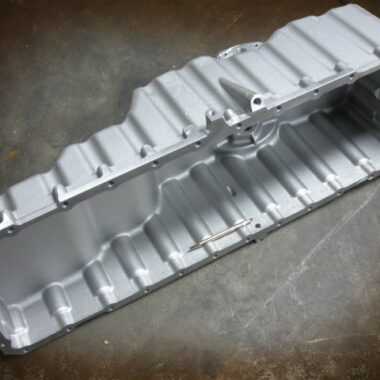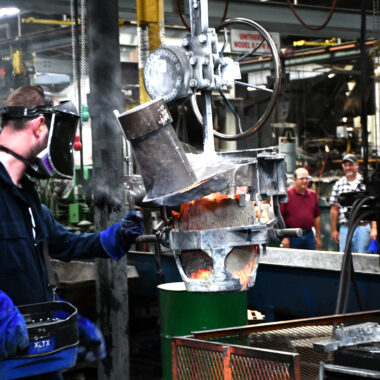Raise Your Production Line: Aluminum Casting Methods That Provide Results
Raise Your Production Line: Aluminum Casting Methods That Provide Results
Blog Article
The Leading Methods for Light Weight Aluminum Casting That You Need to Know
From the conventional sand casting method to the intricate financial investment spreading procedure, each method provides distinct advantages that provide to different job requirements. As we navigate via the leading methods for aluminum spreading, it comes to be obvious that grasping these methods is essential for achieving optimum results.
Sand Casting Strategy
The Sand Spreading Technique is a fundamental approach in light weight aluminum casting, extensively used for its cost-effectiveness and adaptability in creating detailed steel shapes. This strategy includes producing a mold made of compressed sand into which molten light weight aluminum is poured, permitting it to take the form and solidify of the mold and mildew. One of the vital advantages of sand spreading is its capability to produce intricate geometries with relatively reduced tooling costs, making it an eye-catching choice for manufacturers aiming to create one-of-a-kind components.
In the sand spreading process, a pattern of the final part is pressed right into a great sand combination contained within a flask. Sand casting is frequently made use of in numerous sectors, consisting of automotive, aerospace, and art foundries, due to its capability to create both huge and tiny steel parts with detailed designs.

Investment Casting Refine
An elaborate method utilized in aluminum spreading is the Investment Casting Refine, known for its capacity to produce very outlined and detailed metal parts. Likewise described as the lost-wax casting procedure, this technique goes back thousands of years and continues to be a popular option in various markets due to its adaptability and precision - aluminum casting.
The financial investment spreading process starts with the production of a wax pattern, which is coated with a ceramic covering to create a mold. The wax is then thawed out, leaving a cavity in the shape of the preferred component. Molten aluminum is poured into the ceramic mold and mildew, taking and loading the dental caries on the complex details of the initial wax pattern.
This approach is preferred for its ability to create complicated forms with superb surface finish and dimensional accuracy. It is frequently made use of in the manufacturing of aerospace components, jewelry, and industrial machinery where complex layouts are called for. The financial investment spreading procedure offers high repeatability and can produce get rid of very little machining needed, making it a cost-effective choice for many applications.
Permanent Mold Method
Utilizing a different method from the Investment Casting Process, the Permanent Mold Method in aluminum spreading supplies a distinctive strategy for developing steel parts. In this technique, a recyclable mold, usually made from steel or cast iron, is used to form the liquified light weight aluminum. The mold is preheated to a particular temperature before the light weight aluminum is put into it. The heat transfer from the molten steel to the mold and mildew assists in solidifying the aluminum promptly, minimizing the cooling time compared to sand casting.
One of the key benefits of the Long-term Mold And Mildew Technique is the improved surface coating and dimensional precision of the spreadings produced. This method is also recognized for its capability to produce high-strength light weight aluminum components with regular high quality. Additionally, the recyclable nature of the mold makes it a cost-efficient choice for tool to high volume manufacturing runs.
Die Spreading Technology
Using innovative manufacturing processes, pass away casting modern technology presents an extremely reliable method for creating complex light weight aluminum components. This technique entails injecting molten aluminum right into a steel mold and mildew, referred to as a die, at high pressures. The die is specifically created to form the aluminum into the desired type, leading to high accuracy and superb surface area finish.
Die casting offers several advantages. It enables the manufacturing of intricate forms with slim wall surfaces, limited resistances, and smooth surface areas, making it ideal for applications where aesthetic appeals and accuracy are critical. In addition, pass away spreading makes it possible for quick manufacturing prices, lowering total production time and prices.

Lost Foam Spreading Method
Die casting innovation's performance and accuracy in producing aluminum elements lead the way for checking out the Lost Foam Casting Technique as a corresponding manufacturing strategy. Lost Foam Casting, also called evaporative pattern spreading, is a method that uses foam patterns to produce elaborate light weight aluminum parts. This process entails developing a foam pattern that is covered with a refractory product to create a shell. The covered foam pattern is then hidden in sand, and molten aluminum is put right into the mold, vaporizing the discover here foam as it streams in and takes its shape.
One of the crucial benefits of Lost Foam Spreading is its capacity to generate intricate layouts with intricate information that may be testing to achieve via traditional spreading techniques. Furthermore, this strategy eliminates the need for cores, reduces machining procedures, and permits tighter tolerances. Lost Foam Spreading is particularly ideal for small to medium-sized light weight aluminum components that call for high precision and elaborate geometries. aluminum casting. As markets remain to demand my website lightweight yet long lasting components, Lost Foam Spreading shows to be a beneficial approach in the realm of aluminum casting.
Verdict
To conclude, comprehending the top techniques for light weight aluminum casting is important for achieving premium outcomes in the manufacturing process. Sand spreading, financial investment spreading, irreversible mold, die casting, and shed foam casting are all reliable techniques for generating aluminum get rid of different degrees of complexity. By grasping these techniques, makers can guarantee that their items fulfill the wanted requirements and requirements for efficiency and toughness.
From the typical sand spreading technique to the complex financial investment casting procedure, each technique supplies unique advantages that provide to different project requirements.The Sand Spreading Strategy is a fundamental method in light weight aluminum casting, widely used for its cost-effectiveness and flexibility in producing elaborate metal shapes. Lost Foam Spreading, additionally recognized as evaporative pattern casting, is a method that makes use of foam patterns to create complex light weight aluminum components. As markets continue to require light-weight yet long lasting elements, Lost Foam Casting confirms to be an important approach in the world of light weight aluminum spreading.
Sand spreading, financial investment spreading, irreversible mold and mildew, pass away casting, and lost foam spreading are all effective techniques for producing aluminum parts with different levels of complexity.
Report this page